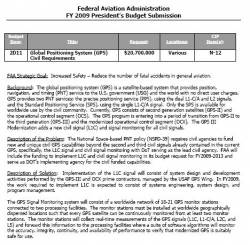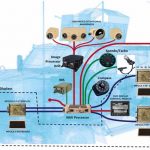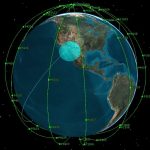 FY09 GPS Budget Request; FAA Line Item
FY09 GPS Budget Request; FAA Line ItemThe GPS program has passed a milestone of sorts with the first allocation of funds from civil agencies to pay for a portion of the core GPS budget.
The Fiscal Year 2008 (FY08) budget for the U.S. Department of Transportation (DoT) sets aside $7.2 million as the first installment on the civil share of GPS modernization efforts, including the L1C signal that will be transmitted on the GPS Block III satellites and costs of monitoring the civil GPS signals in the modernized ground control segment (OCX). For the FY09 budget, the Bush administration has requested a $20.7 million allocation. The total five-year civil contribution (FY09-13) is expected to be more than $200 million.
The GPS program has passed a milestone of sorts with the first allocation of funds from civil agencies to pay for a portion of the core GPS budget.
The Fiscal Year 2008 (FY08) budget for the U.S. Department of Transportation (DoT) sets aside $7.2 million as the first installment on the civil share of GPS modernization efforts, including the L1C signal that will be transmitted on the GPS Block III satellites and costs of monitoring the civil GPS signals in the modernized ground control segment (OCX). For the FY09 budget, the Bush administration has requested a $20.7 million allocation. The total five-year civil contribution (FY09-13) is expected to be more than $200 million.
Since the GPS program’s inception in 1974, expenditures for the core budget (space and control segment infrastructure, operations & maintenance, etc.) have come solely from Department of Defense (DoD) funds channeled through the U.S. Air Force. Civil agencies have financed augmentation programs such as the Wide Area Augmentation Systems (WAAS), the Nationwide Differential Global Positioning System (NDGPS), small-scale research and development projects, for applications of GPS technology in departmental operations.
At a March 20 meeting of the National Space-based Positioning, Navigation, and Timing Executive Committee (PNT EXCOM), DoT representatives confirmed that the FY08 allocation would be split equally between the Federal Aviation Administration (FAA) and the Federal Highway Administration (FHwA) and identified the respective agency funds from which the money will come. The FY09 allotment would all come from FAA. FAA will include funding to implement L1C and civil signal monitoring in its budget request for (FY09–13) and serve as DoT’s implementing agency for the civil funded capabilities, says Paul Feenstra, a public affairs officer in the Reaseach and Innovative Technology Administration (RITA), which coordinates PNT activities for DoT.
Under a 2004 National Security Policy Directive (NSPD-39), any future civil requirements after provision of the L5 civil signal that begins with the Block IIF satellites must be paid for by civil agency budgets. The money will go toward system engineering, design, and eventually purchase of equipment — activities that are overseen by the GPS Wing of the Space and Missile Systems Center at Los Angeles Air Force Base, California.
The GPS signal monitoring system will consist of a worldwide network of 18–21 monitor stations established at widely dispersed sites around the world so that every GPS satellite can be continuously monitored from at least two stations. The stations will collect real-time measurements of the GPS signals (L1C, L1-C/A, L2C, and L5). This information will pass to the processing two processing facilities where a suite of software algorithms will monitor the accuracy, integrity, continuity, and availability of satellite performance.





